Menu
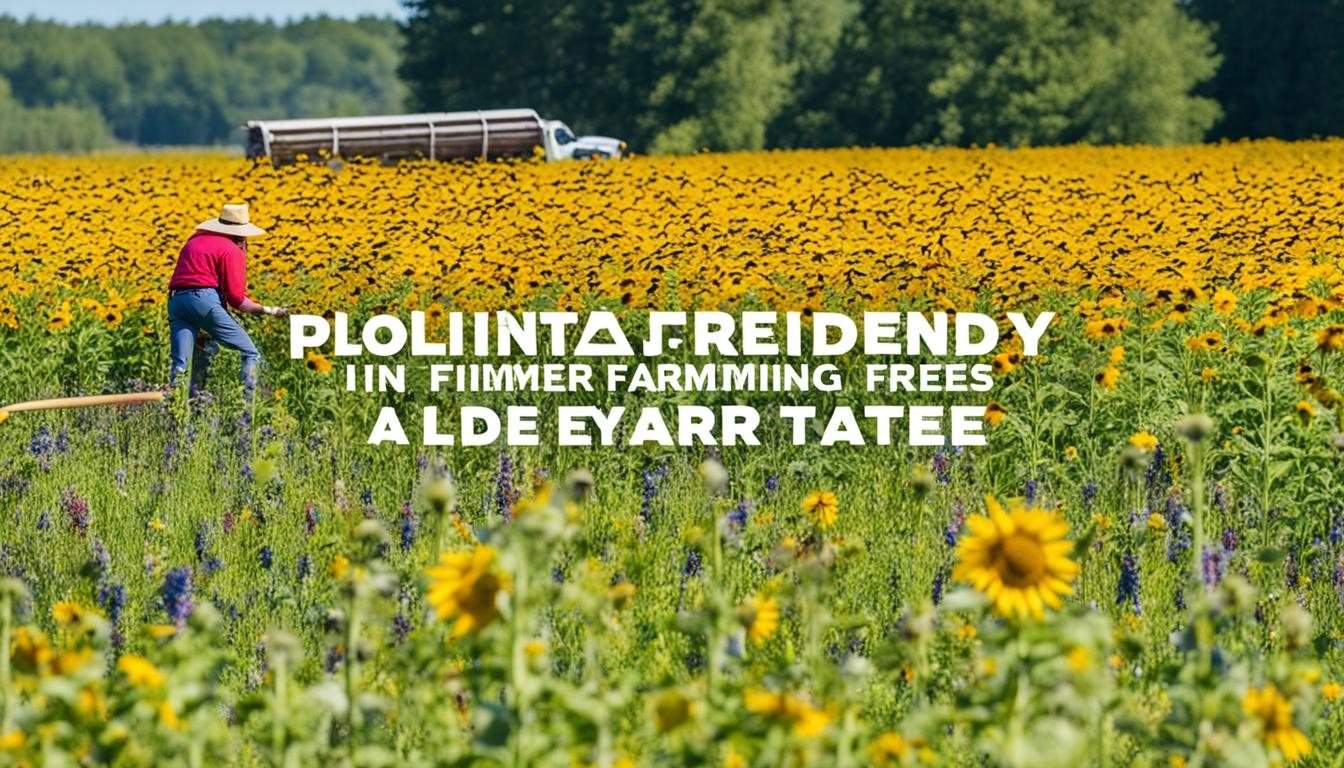
Spring brings my garden to life with many hues. It’s a time to join the World Bee Day celebration. Bees are crucial, not just for pretty flowers but for our food and planet. This makes me explore how farming can help bees thrive.
Every crop they help grow supports us and our economy. Their work boosts American farming by a huge $15 billion each year. So, I see we must protect these little heroes.
Bees are key to keeping nature healthy and our food fresh. They add value to crops and help them last. Still, they’re in danger. This is why we need farming that’s good for bees, like the Bee Friendly Farming® Certification by 2023.
Big brands support this, from Silk Canada to KIND Snacks and almond suppliers in California. They encourage us all to make a difference. Let’s support this important cause.
Pollinators are key to the growth and yield of crops. They are crucial for ecological farming and global food security. We’ll look at how these tiny heroes play a huge part in our food systems and economies.
Bees are crucial among pollinators. Over 3,500 species of them help increase crop yields. This makes ecological farming successful. Many plants and 35% of food crops need animal pollinators. This need shows their critical role in global food security.
Pollinators also bring big economic benefits. They boost crop yields by 24%, generating around $15 billion a year in the US. This link between pollinators and farming’s prosperity is clear.
To keep our food supply secure and farms thriving, we need to care for pollinators. Groups like the Pollinator Partnership and the USDA Bee Research Lab provide vital help. They offer resources and knowledge to help pollinators and farming.
Colony Collapse Disorder (CCD) is an alarming issue that started in 2006. It’s known for workers bees disappearing from hives, leaving the queen and others behind. About 50% of CCD cases show symptoms we can’t explain, making it a mystery.
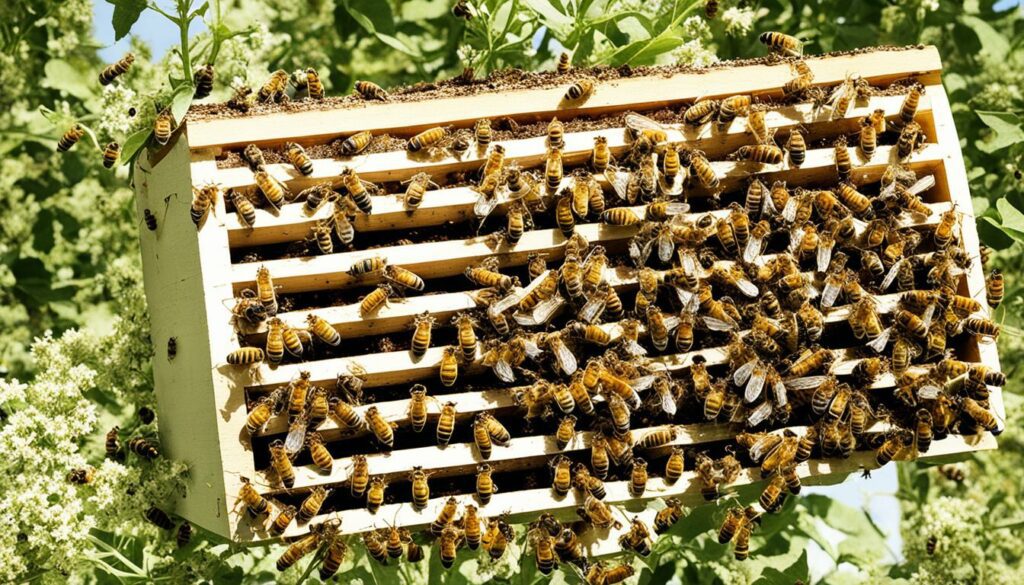
CCD began to hit beekeepers hard in 2006, causing up to 90% loss in some places. Neonicotinoid pesticides might be a cause because they hurt bees in subtle ways. Other possible reasons include pesticide-heavy flowers, diseases, environmental stress, and the pressure of moving hives for pollination.
Bee numbers and the ecosystem are both suffering from CCD. The Western Honey Bee is at serious risk, especially from pesticides and Varroa mites. To help bees, we should keep them diverse and away from harmful chemicals.
From an economic view, bees are crucial, adding $15 billion to the U.S. economy through pollination. They play a massive part in growing our food and keeping agriculture alive. Scientists are working hard to solve the CCD mystery and protect bees.
The facts clearly show why CCD is such a big concern. With the right care, we can save bees, our food, and the environment. This issue highlights the battle we face in today’s farming.
Pesticides have a big impact on bees. They can make pollen toxic, mess with where bees look for food, and lower their ability to fight sickness. These things can make it hard for bees to find their way. This is a big concern for farmers who rely on bees to pollinate their crops.
Many sorts of chemical pesticides can harm bees. A study found that most pollen samples from bee hives had several pesticides in them. Following the instructions on pesticides can help reduce these harmful effects.
| Types of Pesticides | Impact on Bees |
|---|---|
| Synthetic Pesticides | Can cause acute toxicity leading to bee mortality. |
| Natural Pesticides | Less toxic but can still impair foraging patterns. |
| Organic Pesticides | Generally safer but still need cautious application. |
Research shows pesticides can change how bees behave. Bees might not be as good at finding food, which makes pollination less efficient. Bees live in different areas, but if these are sprayed with pesticides, it really messes with their lives.
Monoculture farming, helpful for growing lots of crops at once, is tough for bees. It gives bees only one type of pollen, which isn’t good for them. This lack of varied pollen makes bees weak and sick.
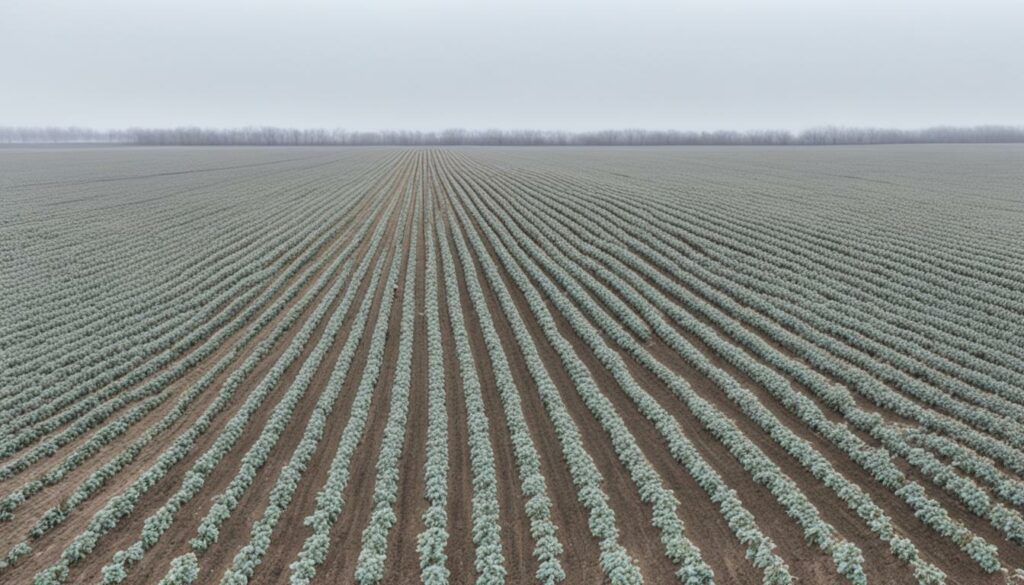
Monoculture means growing just one crop in a big area for a long time. Bees need different kinds of pollen to be healthy. Because they only get one, they are more easily hurt by pesticides from the fields. This makes it hard for bees to stay healthy and do their job.
When bees can’t find different pollen, they don’t eat well. This makes them not grow right, have trouble having babies, and weak against sicknesses. Pesticides used in monoculture are bad for the soil and bees. It’s a harmful cycle.
We need to farm in more ways that help bees and the land.
Regenerative agriculture is changing the face of farming. Big finance is putting lots of money into fixing the climate. This is pushing farmers towards new, eco-friendly methods. Notably, these changes include five-year plans for bee-friendly pollination. Already, this has helped over 50,000 farmers across the world.
Farmers need to shift their focus to regenerative agriculture from using lots of chemicals. In the past, many farmers cared more about how much they produced rather than the health of the land. There’s now a push to change this mindset, with a big part being education. There are also financial schemes to support farmers trying out regenerative methods. These aim to make the change easier.
Regenerative practices have many benefits, such as better soil and higher crop yields. Bees play a huge role because they improve the soil and help plants grow strong. They do this by moving pollen and nectar around. Bees also help create strong, new plant types that can better handle pests and tough environments. Plus, they help keep our ecosystems diverse, which benefits other wildlife and our water.
| Practices | Benefits |
|---|---|
| No-Tillage | Reduces soil erosion, improves soil structure, and enhances water infiltration. |
| Reduced Pesticide Use | Encourages beneficial insect populations and reduces environmental contamination. |
| Crop Diversity | Increases resilience to pests and diseases, and enhances soil fertility. |
| Cover Cropping | Improves soil health and suppresses weed growth. |
Pollination is working to speed up the move to regenerative farming practices. This involves everyone along the supply chain working together. The goal is to change agriculture and food systems for the better. This change is all about learning, both for farmers and the people buying the food. This knowledge will help everyone understand the many upsides of regenerative farming and good soil.
Wildflower planting does a lot to help bees come back. It’s all about planting various flowers like red clover and sunflowers. This creates good pollinator habitats and makes fields more colourful.
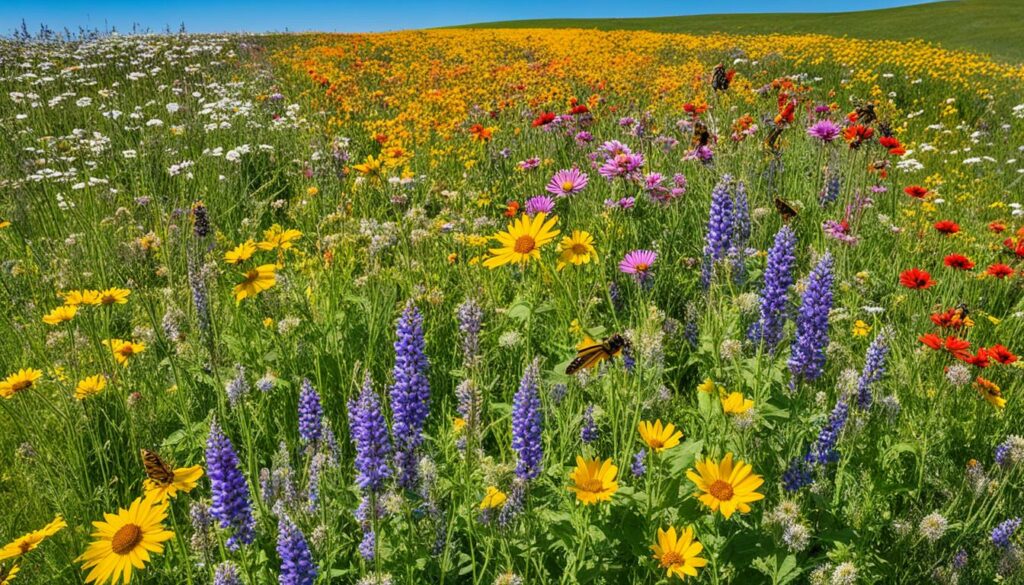
Animals like bees and butterflies add £400 million to UK farming each year. But, their numbers have been going down since the 1950s. This is because of how we farm and the places they used to live changing. Wildflower areas can help them make a comeback, which is good for all of us.
Making spaces for these animals to live brings extra benefits. These places can help control pests naturally and make crop fields better within a year. It’s a win for nature and it also helps keep small farms going strong.
Having flowers around the fields all year long is great for other animals too. It makes a home for many different creatures, helping nature stay in balance. Plus, it acts as a safety zone against harmful farm chemicals, while also helping bees do their job better.
Putting in these wildflower margins does cost money and effort. But, the good that comes from it is worth much more. Also, there might be help available to cover some of the costs, like the Countryside Stewardship schemes.
| Aspect | Benefits |
|---|---|
| Food Production | 35% of global food production benefits from pollinator services. |
| Economic Value | Pollinating insects contribute approximately £400 million annually to UK agriculture. |
| Biodiversity | Season-long flowering plants attract wildlife and enhance floral diversity. |
| Pest Control | Supporting natural enemies within a year of habitat implementation for efficient pest control. |
In the end, growing wildflowers and making diverse areas around crops helps a lot. It makes farming better for the long haul. Plus, it’s a big help for bees and keeps our planet healthy for everyone who comes after us.
Integrated Pest Management (IPM) is a smart way to handle pests. It focuses on being kind to the earth while we protect our crops. We use nature-based strategies to control pests. This helps keep a healthy balance in our fields.
IPM brings many pluses. It cuts down on using harmful chemicals. These chemicals hurt bees and us, causing health problems. Instead, it uses eco-friendly methods like natural predators.
By keeping an eye on pests, we jump into action at the right time. This saves money and stops the pests from ruining our crops.
Working together, like in the Bee Friendly Farming program, is key. Farmers share what they do to spot pests early. They talk about checking traps and keeping records. This makes sure their bug-fighting methods are top-notch.
IPM has a mix of ways to keep pests away. They include:
Using all these methods together makes a strong IPM plan. Even using sprays needs careful thought. We choose them only if nothing else works. This way, we harm fewer helpful bugs.
IPM is not a one-time thing. Farmers need to keep learning and change with the times. This makes sure their pest plans keep working well.
| IPM Approach | Advantages |
|---|---|
| Biological Control | Reduces chemical use, enhances biodiversity |
| Cultural Control | Improves soil health and crop resilience |
| Mechanical Control | Minimises chemical exposure, safer for pollinators |
| Chemical Control (Last Resort) | Effective when budgeted appropriately and used with precision |
In the end, IPM helps keep farming sustainable. By using many methods, we look after bees, keep nature healthy, and keep farming for the future.
Crop rotation is the act of planting varied crops in a specific order. It greatly benefits both the soil and the bees that pollinate. With native bee numbers dropping, it’s clear that nutritional diversity for bees is key.
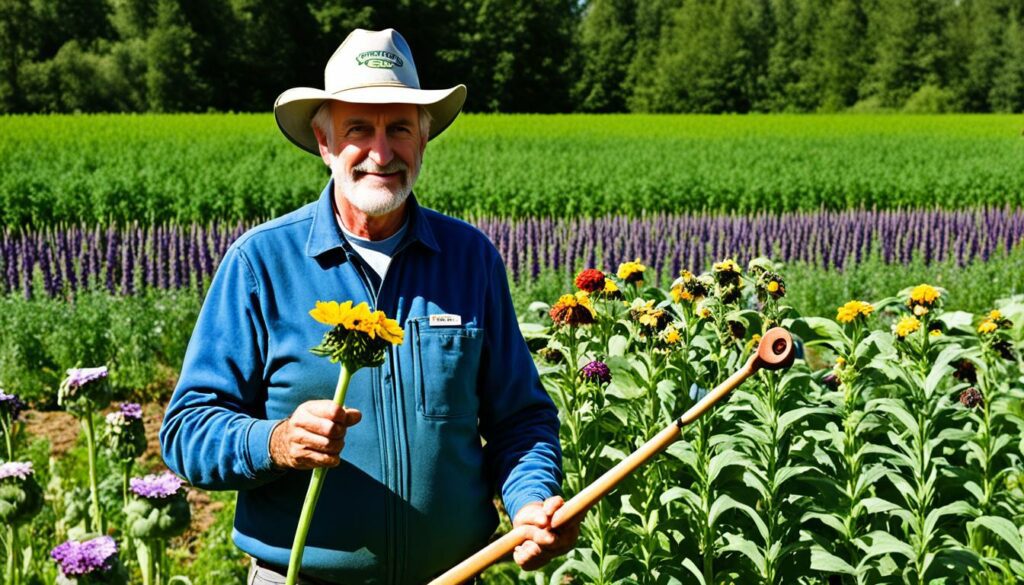
Crop rotation gives bees and other pollinators many food options. Over 100 crops in the U.S. need pollinators to grow, making up 30% of the world’s food. By growing various crops, bees get more food choices, which helps them stay healthy and pollinate better.
This process improves the yield of crops. With more than 100 crop plants needing pollinators, it’s clear varied crops are a must. This mix of crops means bees and other pollinators have a lot to eat and use for their hives.
For thousands of years, farmers have discovered how crop rotation benefits the earth. Each type of crop needs different things from the soil and grows in unique ways. This stops the soil from losing the same nutrients over and over, keeping it rich and healthy.
Also, rotating crops can help fight off pests and stop diseases from growing. Plants like beans and peas can even help the soil be better by adding nutrients to it. Healthy soil doesn’t need as many chemicals, which keeps bees and insects safer.
Programs like the Environmental Quality Incentives Program (EQIP) help farmers use crop rotation. Benefits from this approach help both the economy and the environment. Using crop rotation, we improve the soil and help bees find the food they need. This makes our farms stronger and better for everyone.
| Practice | Benefits |
|---|---|
| Crop Rotation |
|
| Legume Integration |
|
| Pollinator Habitats |
|
Using flowering cover crops is smart for farmers wanting to help the environment. It helps improve the soil, saves water, and provides homes for pollinators. This way, it’s not just about pollinating crops but about a healthier, more biodiverse farm.
There are many flowering cover crops to choose from, each with its own benefits. Some common ones are:
These plants not only attract good insects but also make farming more varied. A lot of farmers, around 38%, now plant cover crops to help pollinators. This shows that more and more people are realising the value of these plants.
The green benefits of flowering cover crops are big. They help more helpful insects like in vineyards where they fight against pests. Plus, these plants keep feeding good bugs even when there are no cash crops around.
Cover crops also mean less need for harmful chemicals. This saves money and makes the soil healthier. For bees, the different foods from these plants can even help them deal with some pesticides. So, these crops are great for bees and support better farming for everyone.
| Cover Crop | Pollinator Benefits | Management Details |
|---|---|---|
| Buckwheat | Attracts more beneficial insects than weedy fallow fields | Optimum planting time: late spring to early summer |
| Phacelia | Enhances bee health and population | Ideal termination time: before full maturity to avoid reseeding |
| Sunflower | Provides substantial forage for pollinators | Best planted in early spring for summer bloom |
| White Dutch Clover | Requires re-seeding every 5 years for sustained benefits | Seeding rate: around 10 lb/acre |
Creating nesting habitats for bees is key for saving their homes. I’ve seen that around two-thirds of native bees make nests in the ground. They like to forage close to home, within 200 yards. This makes protecting their nest areas very important for their future.
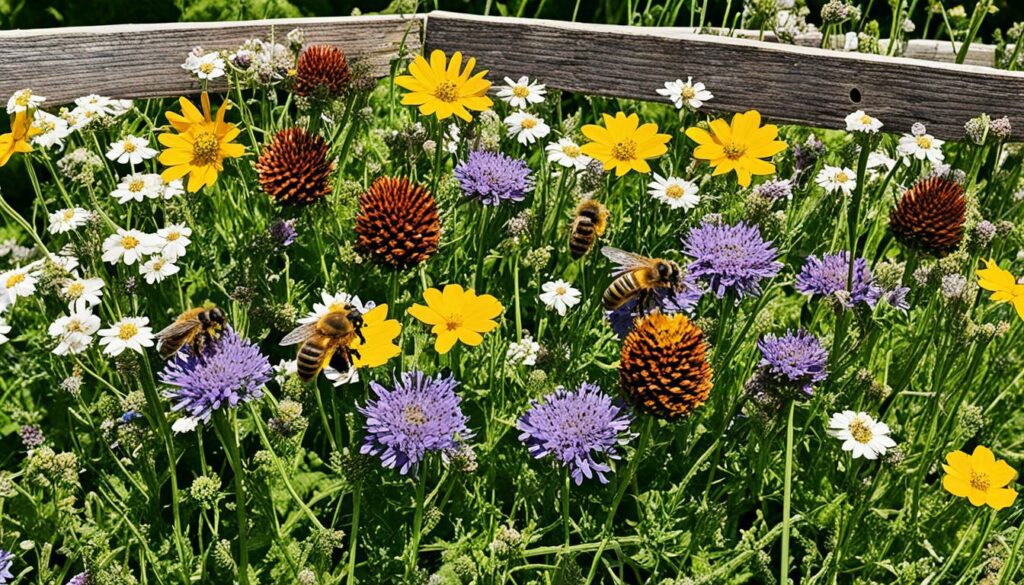
Not tilling the ground often helps these ground-nesting bees. Xerces works to protect pollinators and biodiversity across 1.5 million acres since 2005. This shows how big of a difference saving bee habitats can make.
Help is out there for making bee-friendly areas, from the USDA and Xerces experts. People who own land can use this help to plant areas with grass or leave some soil bare. This makes the area better for bees.
Joining Bee Better Certified and planting cover crops helps too. They are good for the soil, feed the bees, and stop soil from washing away. It helps the bees and makes the farm stronger against changing weather.
Now, let’s look at how all these parts fit together:
| Factor | Benefit | Example |
|---|---|---|
| Reduced Tillage | Preserves nests of ground-nesting bees | Practiced on farms certified by Bee Better Certified |
| Cover Crops | Improves soil health, offers forage | Utilised for weed suppression and erosion control |
| Grassy Areas/Bare Soil | Enhances nesting habitats | Implemented as buffer strips or fencerows |
Farmers are choosing wildlife-friendly ways more and more. They want to be certified as Bee Friendly Farming®. This certification shows their work in helping pollinators through clear and reliable steps.
For almonds, farms need at least 3% land that gives bees good food. The Bee Friendly Farming® certification doesn’t ask for a certain area that blooms every season, though it helps bees.
This certification costs $45 each year. Farmers must also send in a form every three years. A team checks these forms to make sure the farms are really helping wildlife.
Some farmers might find it hard to reach the 3% requirement. They can email bff@pollinator.org for tips and help. The programme could offer some extra support or advice.
Habitat loss greatly affects pollinators. These are animals that help plants reproduce. Three-quarters of all flowering plants rely on pollinators. Their numbers are falling due to cities spreading out and farms using a lot of land.
When cities grow, they take over natural areas. This leaves fewer places for pollinators to find food and build their homes. Bees and butterflies suffer because of too many hard surfaces. Farming also plays a part, especially if it’s always the same crop.
We must turn things around by making better bee homes. Planting local plants in cities and on farms helps. There are many efforts to help farmers do this, such as ones supported by the USDA. These include things like the Environmental Quality Incentives Program and the Conservation Reserve Program.
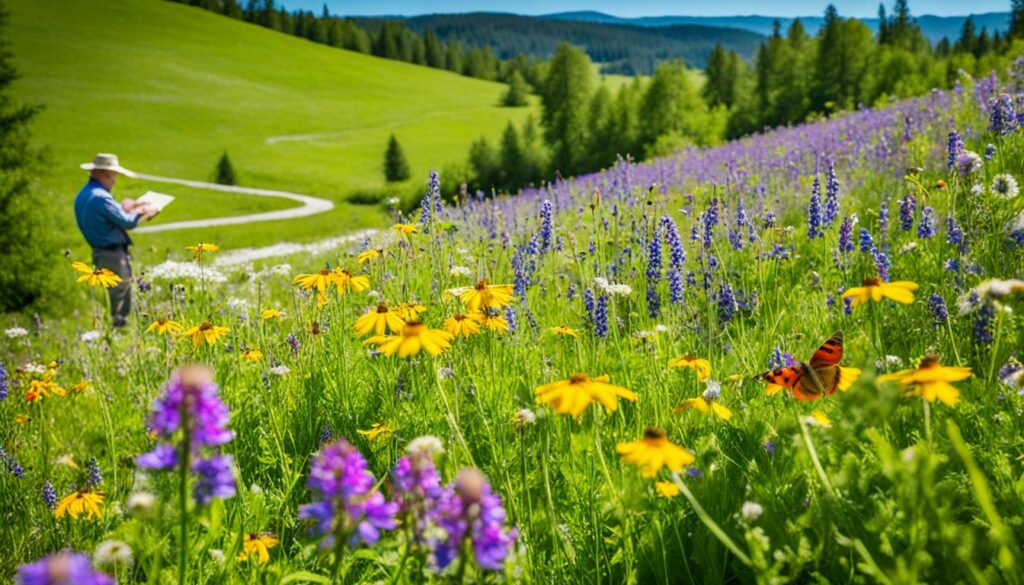
It’s not just about planting any plants. We need to plant what pollinators like to eat. Insects are key to a lot of our food. Helping them helps us all by making sure food keeps growing.
| Program | Benefit |
|---|---|
| Environmental Quality Incentives Program (EQIP) | Financial help for nature-friendly practices |
| Conservation Reserve Program (CRP) | Makes fields into places pollinators love |
| Conservation Stewardship Program (CSP) | Helps farmers in practicing pollinator-friendly farming |
Both cities and farms need to work together to save pollinator homes. We can make our cities greener and still live comfortably. This is good for us and for the pollinators that keep nature going.
Bringing back native plants is key for keeping our area diverse and balanced. Native plants help create strong ecosystems. These areas are important homes and food for insects that help pollinate other plants.
Choosing native over exotic plants keeps our local environment healthy. Native plants are used to the local weather and soil, making them easy to look after. They attract bees and butterflies, which is good for the whole ecosystem.
From 2005, Xerces has helped make over 1.5 million acres of farms more flowery, thanks to their work with the NRCS. This effort has helped farmers and wildlife alike, making the land better for bugs and other beneficial animals.
Using native plants is crucial for local life. They help crop pollinators survive, which is important for farms. Picking plants that bloom at different times ensures there are always flowers for pollinators.
Places with old fields and lots of native plants have more types of pollinators. Projects where people plant hedges or fix coastlines also help a lot. They bring communities together to protect local life.
The Bee Better Certified programme is also making a big difference. It shows which farms are helping pollinators. This makes people more aware of how their food choices can protect our environment.
Bees are vital for our environment, helping with pollination and keeping the ecosystem rich. Yet, they are under threat from several diseases. These illnesses can harm bee populations and, as a result, affect our world’s biodiversity.
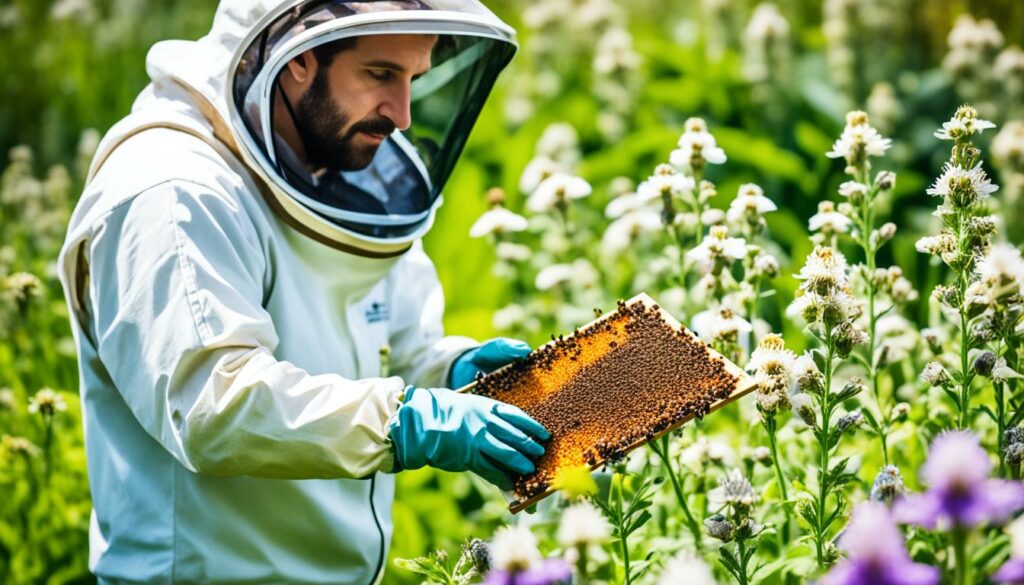
Two key diseases bees face are Varroatosis and American foulbrood. Varroatosis is caused by a mite. American foulbrood is a bacterial problem. Both illnesses can lead to the collapse of beehives. They hurt bees differently: Varroatosis weakens them. American foulbrood kills larvae, affecting the colony’s growth negatively.
Stopping bee diseases is crucial for their well-being. Beekeepers can help by checking their hives often and keeping them clean. This simple step goes a long way in managing diseases. Using methods like integrated pest management also helps. This includes looking at how bees, pests, and diseases interact to find the best solutions.
Scientists are looking at new ways to protect bees. They are trying to breed bees that can fight off diseases better. They are also working on treatments that are natural and safe for the bees.
| Bee Disease | Symptoms | Preventative Measures |
|---|---|---|
| Varroatosis | Deformed wings, weakened bees | Regular hive inspections, mite control techniques |
| American foulbrood | Larval death, foul odour | Good hive management, use of antibiotic treatments |
Invasive parasites are a huge threat to bee colonies. Their impact is both deep and worrying. It’s vital to manage these parasites to protect bees and the ecosystem they support.
The Varroa Destructor mite is a serious global threat to honeybees. It sucks the bees’ haemolymph, weakening them. This leads to health issues in bees, such as deformed wings and shorter lives. It’s an important cause of colony collapse, as shown by Wilfert L et al.’s 2016 research.
To fight threats like the Varroa Destructor, beekeepers need to do a lot. They should check their hives often and use various pest management methods. Research by Goulson D et al., in 2015, showed we need a mix of chemical, biological, and cultural controls. It also mentions the value of raising bees that can resist these parasites.
We must work together to manage invasive parasites. The number of managed honey bee colonies in the US has decreased. This shows we need to act fast to save our bees.
Climate change impact is big and changing how bees and other pollinators do their job. The changing weather hits them hard. Take the case of 2023 in California. A big storm caused a lot of western monarch butterflies to die, 60% of them in fact, when usually it’s 38-49%. These extreme weather events are becoming more common, making it hard for these insects to find food and places to live.
Because of weather patterns going haywire, bees are struggling. More extreme weather means more bees dying. For example, in the west, where Monarchs spend the winter, their numbers decreased by 12% more than usual. Even honey bees are in trouble. The number of colonies in the US has dropped from 5 million in the 1940s to 2.68 million in 2023.
| Statistic | Previous State | Current State |
|---|---|---|
| Monarch overwintering loss | 35-49% | 58% |
| Managed honey bee colonies (US) | 5 million (1940s) | 2.68 million (2023) |
| Die-off rate of western monarchs (California) | 38-49% | 60% |
To fight the negative effects of climate change, we need to farm in a better way. Farming often makes the problems worse by destroying where bees live, reducing plant variety, and using too many pesticides. To help bees and other pollinators, we should farm in a way that uses fewer pesticides and keeps different places where they can thrive. This, combined with efforts to stop climate change, will help bees survive and keep our food coming.
Scientists say that climate change is the biggest danger facing bees. This could change what foods we rely on, like moving to crops that don’t need bees. I’m dedicated to promoting farming that helps the environment. Such practices are key to fighting the effects of climate change and making sure bees and farming work well together.
Wild bees play a huge role in agriculture. They mostly hunt for food close to their homes. This means small, nearby farms are important for their survival.
Helping bees depends on the work of farmers. They must avoid harmful pesticides and create safe spaces for bees. Methods like planting at different times offer continuous food for bees.
The importance of bees is enormous. They help grow three quarters of our main crops. Their work is worth a lot of money, showing how vital they are.
To protect our food and jobs, everyone must step in. We need to make smart choices for the future of farming.
Pollinator-friendly farming uses a mix of flowers and cuts down on pesticides. These methods help bees and other pollinators to live well. They also protect a range of plants from disappearing.
Bees and other pollinators help crops grow by transferring pollen. This process is needed for many plants to make seeds or fruit. Thanks to them, farms produce more and better food.
In CCD, most working bees suddenly vanish, leaving their queen and young bees. First noticed in 2006, it’s caused big drops in bee numbers.
Pesticides harm bees by creeping into their food, affecting their memory and body. These effects can make whole bee colonies weak or disappear.
Having just one crop means bees can’t find enough different pollens. This lack of variety in their diet is bad for their health. Also, more pests mean more pesticides, which harm the bees more.
Regenerative farming boosts the health of the land and its creatures. It encourages plant variety and lowers harmful chemicals, giving bees a better home.
Adding wildflowers at field edges helps bees and other pollinators. It makes the area more diverse and supports a richer ecosystem. This approach helps crops and nature thrive together.
IPM looks at the whole farm to control pests, using different methods together. It cuts down on harmful chemicals. This is good for both crops and bees.
Rotating crops keeps the soil healthy and pests away. Different plants give pollinators more to eat. It’s a win-win for bees and the farm.
Cover crops give bees more food and places to nest. They also keep the soil good for plants. This means a nicer place for everyone, including pollinators.
Farmers can make spots for bees to nest by not stirring the soil and leaving grassy places alone. This helps bees find homes and food.
Bee Friendly Farming® Certification highlights farms that help pollinators. It’s awarded by outside groups and links to supporting eco-friendly brands.
Cities and big farms take away pollinators’ living spaces. Planting local plants and leaving green areas can fix this. They help pollinators live and work better.
Planting local plants gives pollinators good food and a place to live. This makes the area more lively and helps protect nature. It’s good for the whole ecosystem.
Bees face diseases like Varroatosis and American foulbrood. Being careful with the beehives and trying new ideas can stop these diseases. This protects bees.
The Varroa Destructor mite kills bees by making them sick. Keeping an eye on the bees and using safe ways to fight the mites is key to helping the bees survive.
Climate change makes the weather and food for bees unpredictable. Farms that work with nature can help bees cope. This way we have healthy bees and good food.